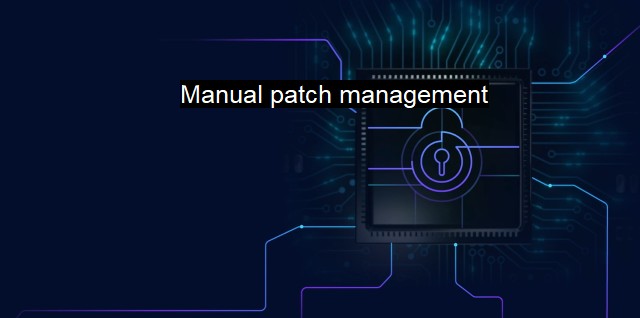What is Manual patch management?
Secure Your Systems with Manual Patch Management: Addressing Known Vulnerabilities and Preventing Cyber Attacks through Software Updates
Manual patch management is a significant aspect within the realm of cybersecurity and antivirus protocols. It refers to a systematic approach used for managing, administering and manually keeping operating systems, software tools, applications, and other systems functional and secure from any prevailing security threats. Patch management entails being aware of emerging system vulnerabilities, identifying relevant patches to address these issues, and implementing these patches to fortify the system from security breaches. The initial recognition that a system requires patching is the first step of manual patch management.Manual patch management involves software administrators or cybersecurity professionals tracking new updates or patches from official software vendors or third-party sources. The updates can be security patches, software upgrades, critical updates, service packs or hotfix that helps in addressing the specific issues or vulnerabilities within a system.
These patches are designed to perform specific actions. For instance, they can rectify software-related problems, fix operating systems errors, resolve software compatibility complains, or counteract any perceivable threats or hazards. Notably, patches don't introduce new features, rather they facilitate an existing software environment to run optimally and securely by correcting problems or vulnerabilities.
Manual patch management works systematically, beginning with the identification of necessary patches, installation and testing, and deployment onto the bigger network. Alertness must be maintained through scanning environment for anomalies, often triggered by absence of patches or their incomplete installation. New alerts lead to a detailed investigation.
Manual patch inspection can be wholesomely demanding but is quintessential in ensuring secure and up-to-date operations of system and application software. It allows an in-depth understanding of the underlying conditions and boosts the careful mitigation of emerging vulnerabilities. It supports validation test best suited to the organization-specific software and can help identify overrides or false positives. any manual process is less susceptible to misconfigurations or automated system failures.
One primary concern related to manual patch management is that it can be time-consuming and prone to errors. Delaying patches or installing incorrect patches can present attack surface for cybercriminals, enabling them to perform malicious activities like launching damaging cyberattacks, causing data breaches, or infecting systems with ransomware or malware. Businesses dealing with a broad range of software from various vendors can find the manual patching task complex and tedious. With a multitude of patches released regularly, manual management may not be sustainable in terms of deployment speed, time, and accuracy.
Despite these limitations, manual patch management still has its unique advantages. It provides greater control in deciding which patches need deployment, thus enabling selective patching, saving crucial system resources. Accurate patch identification helps defend against compliance risks and security vulnerabilities while ensuring uninterrupted business operations by reducing improper or incompatible patch installations.
Some contemporary manual patch management approaches incorporate installation of a testbed environment where patches are duplicated, trialed, and tested without impacting real-time applications. The professionals use this test environment to take detailed notes about how specific patches react with the OS and the different system applications.
Manual patch management plays a strategic role in cybersecurity and antivirus strategies, acting as an early warning system and solution framework for detecting, assessing, and addressing software vulnerabilities. It allows for sophisticated error management and promotes system stability despite its challenging process. effective manual patch management bolsters cyber resilience by limiting the exposure to potential cyber threats and preventing security compromises. It’s essential in a world increasingly reliant on digital systems and networks.

Manual patch management FAQs
What is manual patch management in the context of cybersecurity and antivirus?
Manual patch management refers to the process of updating and installing software patches manually, without relying on automated tools. In the context of cybersecurity and antivirus, manual patch management involves identifying vulnerabilities in software and applying available patches to address those vulnerabilities manually.Why is manual patch management important in cybersecurity and antivirus?
Manual patch management is important in cybersecurity and antivirus because it helps organizations stay up-to-date with the latest security patches and protect their networks from known vulnerabilities. It also helps organizations ensure that all software is patched properly and that the patching process does not introduce new vulnerabilities.What are some challenges associated with manual patch management in cybersecurity and antivirus?
Some of the challenges associated with manual patch management in cybersecurity and antivirus include the time and resources required to manually identify and apply patches, the risk of human error during the patching process, and the need to maintain an accurate inventory of all software and systems within an organization.What are some best practices for manual patch management in cybersecurity and antivirus?
Some best practices for manual patch management in cybersecurity and antivirus include creating a formal patch management process and schedule, prioritizing patches based on their severity and impact, testing patches before deploying them to production systems, maintaining an accurate inventory of all software and systems, and ensuring that all patches are properly documented and tracked.| | A | | | B | | | C | | | D | | | E | | | F | | | G | | | H | | | I | | | J | | | K | | | L | | | M | |
| | N | | | O | | | P | | | Q | | | R | | | S | | | T | | | U | | | V | | | W | | | X | | | Y | | | Z | |
| | 1 | | | 2 | | | 3 | | | 4 | | | 7 | | | 8 | | |||||||